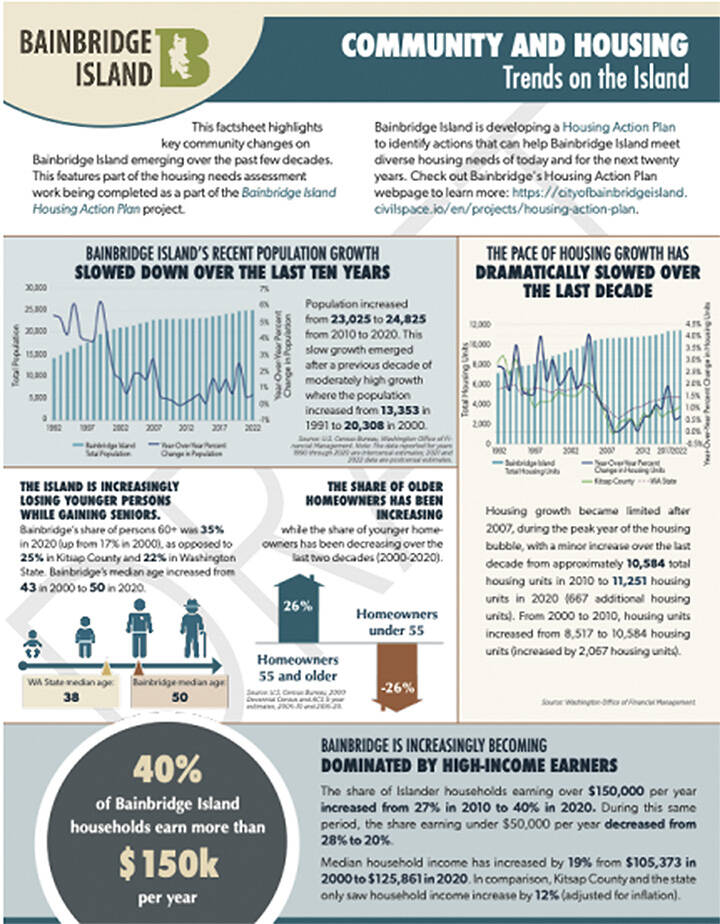The Bainbridge Island Planning Commission recently gave its OK to send the revised draft Housing Action Plan to the City Council for approval prior to a June 30 deadline for a $100,000 state grant.
HAPs address affordable and market-rate housing needs through strategies and actions to encourage greater housing diversity, affordability, and access to opportunity for residents of all income levels. After a public hearing and consideration of the draft, the Planning Commission recommended specific considerations for the council related to adopting the final HAP.
Commission co-chair Ashley Mathews said city staff went above and beyond in getting “what was in our heads” as the process moves forward.
Commission members Sean Sullivan, Peter Schaab and Benjamin Deines agreed their recommendation for a scorecard is an important metric for transparency and accountability.
Schaab said he was disappointed they didn’t create a framework for prioritization. “Somebody has to do that work,” he said, adding now it will be left up to the council.
But Deines said ultimately everything the commission does gets “kicked to the council” because it’s the final authority. “I appreciate how staff circled back and closed the loop. I love that we’ll be able to track the progress of the plan.”
Commission requests
The commission asked the council to:
1. Direct staff to prepare a twice-yearly scorecard that evaluates the city’s progress toward meeting the HAP strategies.
2. Direct staff to prepare a memo for the Winslow Subarea Planning process and the Comprehensive Plan Steering Committee that identifies the specific actions within the HAP that could coincide with their processes.
3. Identifies actions the Planning Commission can initiate with council’s direction that would not fall under the Comp or Subarea Plan processes.
Staff agreed with the second item, but said the first and third ones would be difficult to handle with their workload. However, if council agreed with the commission it would need to become a priority.
Even though it didn’t make the decision, the commission discussed how HAP actions could be prioritized: Actions that relate to monitoring or data gathering and analysis; actions that provide support to existing residents or programs inside and outside City Hall; actions that do not have dependencies; and actions that have high-impact quick wins.
The HAP
The city and ECONorthwest partnered for the HAP to identify ways to meet housing needs now and into the future. The HAP provides a factual basis for revising policies and implementing strategies for the Comp Plan Housing Element and could inform subarea planning and strategic planning efforts.
Sets of action include:
• Housing Needs Assessment: Gain a deep understanding of the housing market dynamics, unmet housing needs, and housing projections. Build a multifaceted comprehension of housing market dynamics, existing regulatory influences, and housing needs of today and for the next 20 years.
• Community Engagement: Inclusively involve and educate BI stakeholders on housing challenges and decisions.
• Strategy development: Develop and evaluate strategies, informed by data, engagement, and priorities. Develop strategies and actions designed to inclusively meet the housing needs of Bainbridge communities and workers.
• HAP and Implementation Plan: Refine strategies and deliver a final HAP. Provide an Implementation Plan including key guidance such as the timing of actions, who will implement, resource needs, and identifying monitoring and performance measurements to track plan implementation.
Guiding principles include: more diverse housing types; increase affordable housing; stabilize households and prevent displacement; support housing for seniors and special populations; increase housing for Bainbridge workers; and encourage sustainable development.
To improve the housing situation on BI, the city needs to look at: incentives, policy changes, technical assistance, financial support, partnership building, research and monitoring, and direct support for residents, the HAP says.
Incentives can include things like bonus density and raising height limits to fit more homes in smaller spaces.
Best practices
BI isn’t going to have to reinvent the wheel, or foundation in this case. The 155-page draft HAP includes sections on best practices. Many examples already are on BI, with the furthest example in Eugene, OR.
For accessory dwelling units, the HAP lists the Olympia area as having great examples. For cottage housing, look no further than Eugene. For co-living, Portland, OR has a fine example.
BI has standout examples of tiny homes with a high school project. For housing design, look at the Grow project. The Morales farm intern housing was also cited as a best practice, as was partnering with Housing Resources Bainbridge.
For using an affordable housing levy, look at Bellingham, and Tacoma has done an exemplary job with tenant relocation. Finally, Amazon has a standout housing equity fund, the HAP says.



